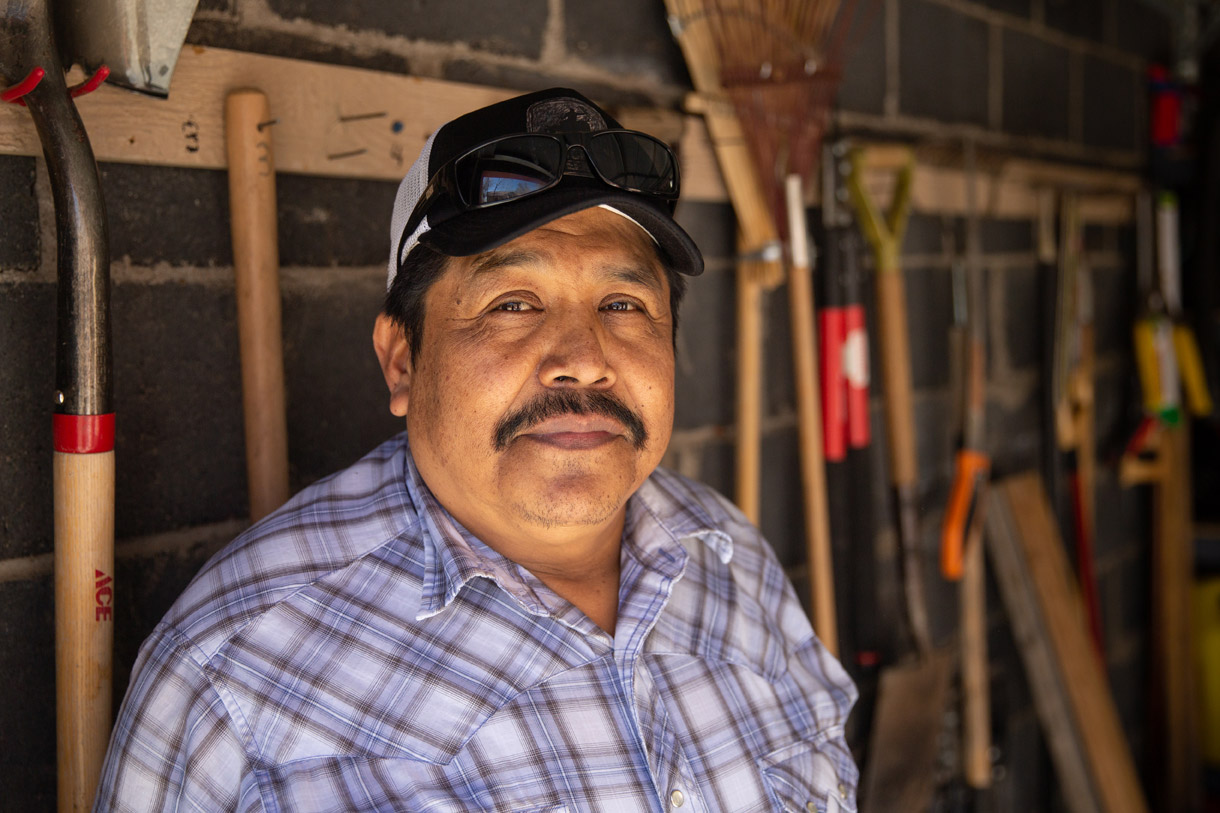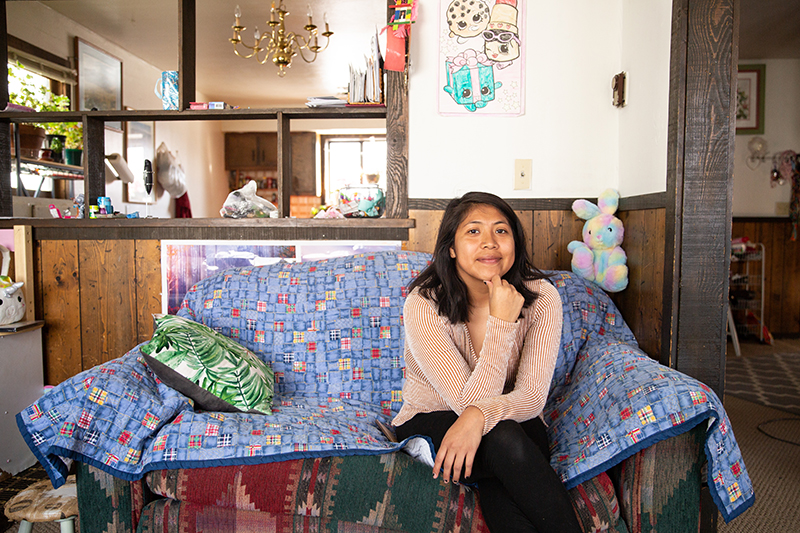
Magdaleno Diaz has long served as a conduit between the Cora community and the rest of Gunnison County. Photos by Luna Anna Archey
Magdaleno Diaz has long served as a conduit between the Cora community and the rest of Gunnison County. Photos by Luna Anna Archey
In the spring of 2020, when Gunnison County was one of the nation’s first hotspots for COVID-19, one small, unique group in this Western Slope county was particularly well-suited to withstand a pandemic. It was also especially hard-hit.
The Cora, Indigenous people who have been migrating from a mountainous ranching community in the Sierra Madre Occidental Mountains east of Guadalajara, Mexico, to the mountainous ranching country of Gunnison County for almost half a century, faced the first year of the COVID-19 pandemic with language and cultural barriers.
The 160 or so Cora currently living in and around Gunnison—mainly in two mobile home parks—normally tend to stay in their tight-knit family groups. So, the pandemic lockdown and not interacting with people outside their homes came somewhat easy.
Many of the Cora also work side-by-side with family members. The majority are employed at tourism-related cleaning, restaurant and construction jobs in Mt. Crested Butte—a town they refer to as “the mountain.”
When COVID-19 infection rates shot up in Gunnison County in early March 2020, around the same time Gov. Jared Polis declared a state of emergency in Colorado, the county went into a strict lockdown mode. That included closing the county to visitors, asking second homeowners to leave and shuttering many businesses.
With the tourist businesses strangled, most of the Cora were out of work or working drastically reduced hours. Like many working-class Gunnison Valley residents, the Cora were hard-pressed to come up with rent, utility payments and food. But the unemployment and stimulus payments that helped other workers weren’t options for the many Cora in the country without documentation.
“They were afraid—not just of the virus,” said Magdaleno Diaz, a longtime Cora resident of Gunnison who is well-known for his volunteer work in the community, and for acting as a conduit between the Cora community members and the rest of Gunnison County.
Gunnison County officials and nonprofit leaders had a lot to grapple with as COVID-19 numbers climbed. From the beginning, the county took extra measures to reach out to a population that has been a part of that community since the early 1970s.
Volunteers and workers with the Gunnison arm of the Hispanic Affairs Project hung informational fliers on doors at the trailer parks where many Cora live. (Hispanic Affairs Project is a Colorado Trust grantee.) They phoned Cora families to inform them about COVID-19 and urge them to be tested. They stressed that it was necessary to stay home if they were ill. They also disseminated information about the availability of food, rent and utility assistance.
None of this was easy because the Cora have their own language—a dialect that is closer to that of the Ute tribes than to Spanish. Many Cora adults speak only Cora and do not read or write. Their children who are in school have learned to speak English, and the schools normally help to get information to the overall Cora population through the Cora students. With schools shut down, that avenue was gone.
Going door-to-door was not a good option because the Cora tend to be shy and fearful, due to the language barrier and some of their documentation statuses. Diaz said they were reluctant to go for testing or treatment because they were afraid it could put them in legal jeopardy.
In the first three weeks of county COVID-19 testing, not a single Latino or Cora came to be tested, according to Gunnison County Health Department data. The county’s coronavirus data dashboard showed that of 707 self-reports of possible COVID-19 symptoms in the early weeks of the pandemic’s arrival in Gunnison County, only four such reports were made in Cora or Spanish.
By September, 66% of all the positive cases in Gunnison County were among Latinos. (The county has not created a separate data category for Cora, and includes them here.)
“This population does not like to come in for any services very often,” said Devan Haney, the multicultural resources director for Gunnison County who was tasked with finding ways to reach the Cora in a pandemic.
Several adult members of the Cora population who speak English, including Diaz, became invaluable resources to not only disseminate information but also quell fears about seeking help.
“We are all related somehow. We help each other out. But it was hard. We needed help,” said Brianda Aguilar, who was born and raised in Gunnison to Cora parents and grew up speaking Cora. “There was so much fear in the Cora population. It was all just overwhelming.”

Brianda Aguilar at her home in Gunnison.
Aguilar’s family had problems typical for Cora families riding out the pandemic. Normally, Aguilar’s family survives on three service-wage incomes. Her father came down with COVID-19 early in the lockdown and was out of his housecleaning job for a month. Brianda and her mother developed lesser cold-like symptoms but were not tested for COVID-19. They all had to isolate. When they could work, their hours were less than half of usual.
Emigrantes Unidos de Gunnison helped the Aguilars with rent assistance at their small home near downtown Gunnison. The Gunnison Country Food Pantry left boxes of groceries at their door. Brianda was so grateful that she began to volunteer at the food pantry—work that she has continued to this day.
If the Gunnison community had not been welcoming to the Cora in so many ways for so many years, weathering the pandemic could have been much worse.
Gunnison’s active nonprofit network had recognized in the early 2000s that a unique ethnic group had gradually made the Gunnison Valley its home, comprising as much as 40% of the area’s Latino population. The Gunnison-area group of Cora is now believed to be the largest living together in the United States.
Initially, single young men came to the area to work as shepherds in the early 1970s. When crossing the border became too dangerous and expensive, and the drug trade grew to a menace, they began to remain in the Gunnison region and eventually bring their families.
They came from an area in the Mexican state of Nayarit which has an estimated population of 25,000 Cora. Most of the Gunnison Cora come from one town called Jesús María.
More than a decade ago, the Gunnison County Health Department was able to research and publish a booklet of helpful information about the Cora through a four-year statewide effort called the Supporting Immigrant and Refugee Families initiative (funded by The Colorado Trust). Cora Indians of Mexico includes information on the Cora language, culture, religion, health practices and migration history.
Marketa Zubkova, an immigrant from the Czech Republic who has lived in the Gunnison area for more than a decade, was instrumental in shedding light on the Cora in Gunnison County’s midst. Zubkova works with the Hispanic Affairs Project, providing immigration legal assistance.
“I wanted everyone to know that they are a very specific Indigenous group,” Zubkova said.
Through interviews with Gunnison migrants and travel to Jesús María, Zubkova was able to describe a people that have been propelled over the border by poverty and the violent drug trade in their home country. More than 60% of residents of the Nayarit area where Jesús María is located are reported by the Mexican Ministry of Social Development to live in extreme poverty.
Diaz said that in recent decades, this mountainous rural area of Mexico has finally been linked to electricity, running water and sewer, but many residents, especially the elderly, still suffer extreme poverty. He said money sent by Cora working in the United States helps sustain relatives living in the Jesús María area.
The Coras’ traditional beliefs about health that are outlined in the booklet help to highlight why explaining a pandemic to the Cora has been problematic. The booklet states (and Diaz confirms) that the Cora believe illness can be a punishment for neglecting religious obligations or for being out of balance with nature. Coras often turn to traditional healers, who are considered to be a bridge between God and man, when they do get sick. Healing methods include using herbal remedies and sucking on rocks and corncobs.
Recently, health beliefs from their home country have affected the Coras’ response to the pandemic.
Diaz and Aguilar said friends and family members in Nayarit have been wrongly warning the Gunnison County Cora to not get vaccinated for COVID-19 because the injection could kill them—inaccurately believing that people in Mexico are dying from the shots.
“Many are terrified of the vaccine,” Aguilar said. “They can’t have a conversation with a doctor. It is hard to explain to them to let them know why they should get it.”
The county is trying nonetheless. The Gunnison County Health Department recently held a Saturday vaccine clinic specifically for Spanish and Cora speakers. Cora interpreters and Spanish students from Western Colorado University were on hand to help people through the process. More than 200 Spanish and Cora speakers showed up for the shots after outreach efforts, including informational Facebook videos and a livestream with a Cora family talking about why they would be getting vaccinated, convinced many that the vaccines were safe and needed.
Diaz did his part by getting his vaccine early and spreading the word that it had not harmed him.
“I talk to people about my vaccine. I tell them how I felt afterwards,” Diaz said. “We also made a paper about it so they can read that.”
Going forward, Haney said there will be more vaccine clinics directed at Latinos, including the Cora. Popup clinics are being planned and pastors are being recruited to talk about the importance of vaccines. Emigrantes Unidos will continue to host virtual education seminars on the first Friday of every month.
There are signs all of these efforts are working. From the first of the year when Gunnison County began administering vaccinations, the vaccination rate for the Latino population of the county had stood at 0.3%. That jumped to more than 20% as of early April. Even though there is no breakdown of how many Cora were included, the volunteers noted there were Cora community members among those lined up for the vaccinations. Diaz said he counted about 65 Cora at the clinic.
Cora residents like Aguilar and Diaz want to help usher in more integration, when appropriate, between the Cora and their adopted community—in normal times, as well as during the crisis of a pandemic.
“We are trying to [get involved] more in the community. We have to show who we are,” Diaz said. “The community—they want to know about us. We are stepping out to show that.”